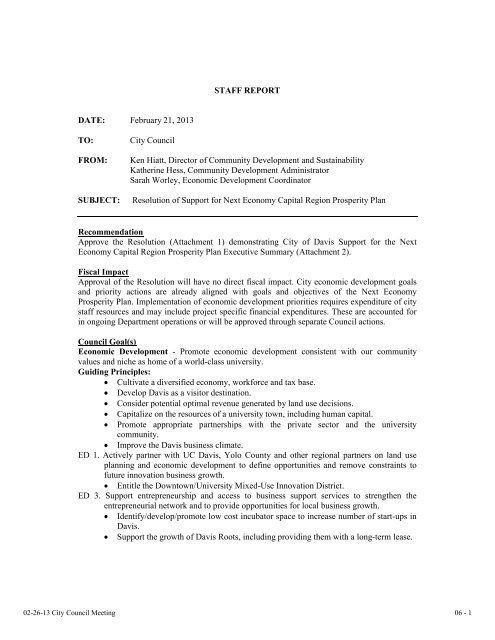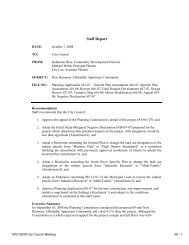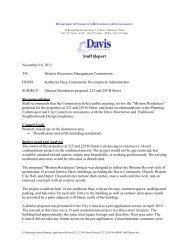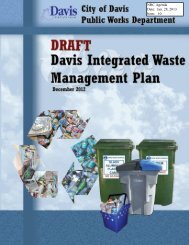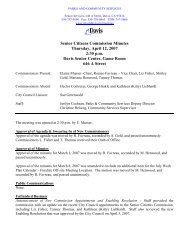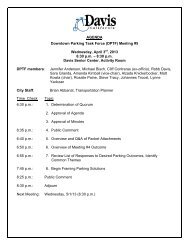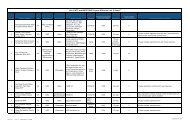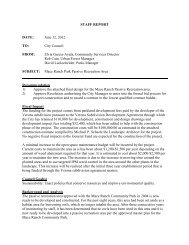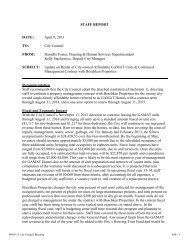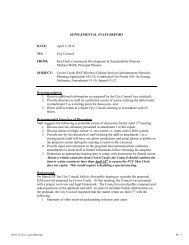06 Next Economy Prosperity Plan - City Council - City of Davis
06 Next Economy Prosperity Plan - City Council - City of Davis
06 Next Economy Prosperity Plan - City Council - City of Davis
You also want an ePaper? Increase the reach of your titles
YUMPU automatically turns print PDFs into web optimized ePapers that Google loves.
DATE: February 21, 2013<br />
TO: <strong>City</strong> <strong>Council</strong><br />
STAFF REPORT<br />
FROM: Ken Hiatt, Director <strong>of</strong> Community Development and Sustainability<br />
Katherine Hess, Community Development Administrator<br />
Sarah Worley, Economic Development Coordinator<br />
SUBJECT: Resolution <strong>of</strong> Support for <strong>Next</strong> <strong>Economy</strong> Capital Region <strong>Prosperity</strong> <strong>Plan</strong><br />
Recommendation<br />
Approve the Resolution (Attachment 1) demonstrating <strong>City</strong> <strong>of</strong> <strong>Davis</strong> Support for the <strong>Next</strong><br />
<strong>Economy</strong> Capital Region <strong>Prosperity</strong> <strong>Plan</strong> Executive Summary (Attachment 2).<br />
Fiscal Impact<br />
Approval <strong>of</strong> the Resolution will have no direct fiscal impact. <strong>City</strong> economic development goals<br />
and priority actions are already aligned with goals and objectives <strong>of</strong> the <strong>Next</strong> <strong>Economy</strong><br />
<strong>Prosperity</strong> <strong>Plan</strong>. Implementation <strong>of</strong> economic development priorities requires expenditure <strong>of</strong> city<br />
staff resources and may include project specific financial expenditures. These are accounted for<br />
in ongoing Department operations or will be approved through separate <strong>Council</strong> actions.<br />
<strong>Council</strong> Goal(s)<br />
Economic Development - Promote economic development consistent with our community<br />
values and niche as home <strong>of</strong> a world-class university.<br />
Guiding Principles:<br />
Cultivate a diversified economy, workforce and tax base.<br />
Develop <strong>Davis</strong> as a visitor destination.<br />
Consider potential optimal revenue generated by land use decisions.<br />
Capitalize on the resources <strong>of</strong> a university town, including human capital.<br />
Promote appropriate partnerships with the private sector and the university<br />
community.<br />
Improve the <strong>Davis</strong> business climate.<br />
ED 1. Actively partner with UC <strong>Davis</strong>, Yolo County and other regional partners on land use<br />
planning and economic development to define opportunities and remove constraints to<br />
future innovation business growth.<br />
Entitle the Downtown/University Mixed-Use Innovation District.<br />
ED 3. Support entrepreneurship and access to business support services to strengthen the<br />
entrepreneurial network and to provide opportunities for local business growth.<br />
Identify/develop/promote low cost incubator space to increase number <strong>of</strong> start-ups in<br />
<strong>Davis</strong>.<br />
Support the growth <strong>of</strong> <strong>Davis</strong> Roots, including providing them with a long-term lease.<br />
02-26-13 <strong>City</strong> <strong>Council</strong> Meeting <strong>06</strong> - 1
Work with UC <strong>Davis</strong>, SARTA, SEED Central and other industry partners to develop<br />
an Ag Innovation Center.<br />
Pursue dispersed innovation center strategy, including centers at the east and west<br />
edges <strong>of</strong> the <strong>City</strong>.<br />
Maximize benefits <strong>of</strong> existing inventory and increase supply <strong>of</strong> flexible business<br />
space.<br />
Background<br />
<strong>Next</strong> <strong>Economy</strong> – Capital Region <strong>Prosperity</strong> <strong>Plan</strong><br />
The <strong>City</strong> and UC <strong>Davis</strong> are participating in a collaborative regional process to develop a <strong>Next</strong><br />
<strong>Economy</strong> - Capital Region <strong>Prosperity</strong> <strong>Plan</strong>. This plan is to provide a “road map” to strategically<br />
align regional resources and efforts to improve our regional economy. The <strong>Prosperity</strong> <strong>Plan</strong><br />
builds <strong>of</strong>f <strong>of</strong> the region’s competitive strengths, defines five overarching goals for regional<br />
execution and maps out a set <strong>of</strong> interlocking strategies and objectives to accelerate job and<br />
wealth creation.<br />
As stated in the Executive Summary (Attachment 2):<br />
“<strong>Next</strong> <strong>Economy</strong> poses a region-wide call to action: Mobilize private industry,<br />
government, academic and civic leadership to focus on a set <strong>of</strong> common strategies and<br />
actions to accelerate job creation and new investment in California’s Capital Region<br />
with the goals <strong>of</strong> supporting innovation and entrepreneurship, diversifying the regional<br />
economy, and improving the business climate for economic growth.”<br />
Development <strong>of</strong> the <strong>Prosperity</strong> <strong>Plan</strong> has involved Valley Vision, Sacramento Area Regional<br />
Technology Alliance (SARTA), Sacramento Area Commerce and Trade Organization (SACTO),<br />
Sacramento Metro Chamber, local and county governments, universities, businesses and nonpr<strong>of</strong>it<br />
organizations. First phases <strong>of</strong> the process included: collection <strong>of</strong> data on the regional<br />
economy and regional industry clusters; prioritization <strong>of</strong> objectives; and development <strong>of</strong> the<br />
Vision and Goals. Development <strong>of</strong> an Implementation <strong>Plan</strong> outlining strategic actions to be<br />
pursued is underway and expected to be completed this spring.<br />
The final <strong>Plan</strong> will be comprised <strong>of</strong> three distinct parts:<br />
1. The Executive Summary sets the strategic framework for the five major regional<br />
economic development goals that enables jurisdictions and organizations to participate in<br />
implementing particular actions that suit the specific needs <strong>of</strong> those they serve or their<br />
unique capabilities.<br />
2. The Strategic <strong>Plan</strong> provides the in-depth narrative context behind the goals, strategies<br />
and actions.<br />
3. The Implementation <strong>Plan</strong> will define very specific actions; the lead champions who will<br />
drive results; timetables and performance measures. It is intended to be a living<br />
document – updated and refined regularly based on changing conditions, market demand,<br />
new opportunities or unforeseen challenges.<br />
Preparation <strong>of</strong> a Regional Comprehensive Economic Development Strategy (CEDS) that meets<br />
the Federal Economic Development Administration’s guidelines, and satisfies eligibility<br />
requirements for federal funding grants is another objective <strong>of</strong> the effort.<br />
02-26-13 <strong>City</strong> <strong>Council</strong> Meeting <strong>06</strong> - 2
The four regional organizations cited above are entering into formal agreements with one another<br />
outlining how they will work together to guide implementation <strong>of</strong> the <strong>Prosperity</strong> <strong>Plan</strong>. These<br />
agreements will specify the roles, accountability measures, performance obligations and<br />
implementation commitments that each <strong>of</strong> the organizations is responsible to achieve.<br />
Request for Resolutions <strong>of</strong> Support<br />
<strong>Next</strong> <strong>Economy</strong>’s leadership group is seeking unanimous support for the <strong>Prosperity</strong> <strong>Plan</strong> via<br />
resolutions or other forms <strong>of</strong> endorsement from all business, government leaders, education<br />
institutions, not-for-pr<strong>of</strong>it economic development organizations and private industry in the<br />
region.<br />
The <strong>City</strong> <strong>of</strong> <strong>Davis</strong>’s economic development goals and priority actions are already aligned with<br />
those outlined in the <strong>Prosperity</strong> <strong>Plan</strong>. Accomplishment <strong>of</strong> <strong>City</strong> and regional economic<br />
development priorities will be beneficial to local and regional efforts.<br />
The <strong>City</strong> <strong>Council</strong> previously reviewed the Executive Summary <strong>of</strong> the <strong>Next</strong> <strong>Economy</strong> Capital<br />
Region <strong>Prosperity</strong> <strong>Plan</strong> as an informational item as part <strong>of</strong> the October 9, 2012 Economic<br />
Development Update. The Business and Economic Development Commission reviewed the<br />
Executive Summary as an informational item at their December 10, 2012 meeting.<br />
Adopting a Resolution <strong>of</strong> Support for the <strong>Next</strong> <strong>Economy</strong> Capital Region <strong>Prosperity</strong> <strong>Plan</strong><br />
demonstrates the <strong>City</strong>’s concurrence with the plan and its willingness to engage in development<br />
and execution <strong>of</strong> an Implementation <strong>Plan</strong> and local actions necessary to achieve the goals. <strong>City</strong><br />
representatives have and will continue to participate in this effort, including the “Ag/Food<br />
Cluster”, and “Innovation” subcommittees.<br />
The following excerpts from the plan listing the “Core Business Clusters” to be focused on and<br />
new unified “Vision” and “Goals” for the Capital Region confirm their alignment with local<br />
priorities.<br />
Core Business Clusters<br />
Advanced Manufacturing<br />
Agriculture & Food<br />
Clean Energy Technology<br />
Education & Knowledge Creation<br />
Information & Communications Technology<br />
Life Sciences & Health Services<br />
Vision - Within five years, the Capitol Region will be widely regarded as a:<br />
1. Sought-after place for business growth, investment and entrepreneurship<br />
2. Desirable place for young pr<strong>of</strong>essionals to live, study, work and play<br />
3. Diverse economy renowned for its core business clusters and driven in large part by<br />
export activity<br />
02-26-13 <strong>City</strong> <strong>Council</strong> Meeting <strong>06</strong> - 3
Goals<br />
1. Foster a strong innovation environment<br />
2. Amplify the Region’s global market transactions<br />
3. Diversify the economy through growth and support <strong>of</strong> core business clusters<br />
4. Grow and maintain a world-class talent base<br />
5. Improve the regional business climate for economic growth<br />
A copy <strong>of</strong> the <strong>Next</strong> <strong>Economy</strong> Capital Region <strong>Prosperity</strong> <strong>Plan</strong> Executive Summary is provided as<br />
Attachment 2. A set <strong>of</strong> frequently asked questions about the <strong>Prosperity</strong> <strong>Plan</strong> is provided as<br />
Attachment 3. Additional information about the <strong>Prosperity</strong> <strong>Plan</strong> and process is available at the<br />
<strong>Next</strong> <strong>Economy</strong> website http://www.nexteconomycapitalregion.org/<br />
Attachments<br />
1. Resolution <strong>of</strong> Support<br />
2. <strong>Next</strong> <strong>Economy</strong> Capital Region <strong>Prosperity</strong> <strong>Plan</strong> Executive Summary<br />
3. <strong>Next</strong> <strong>Economy</strong> FAQ<br />
02-26-13 <strong>City</strong> <strong>Council</strong> Meeting <strong>06</strong> - 4
RESOLUTION NO. 13-XXX, SERIES 2013<br />
A RESOLUTON OF THE CITY OF DAVIS ENDORSING THE NEXT ECONOMY<br />
REGIONAL PROSPERITY PLAN AND AUTHORIZING THE CITY MANAGER TO<br />
ALIGN THE CITY ECONOMIC DEVELOPMENT EFFORTS IN SUPPORT OF ITS<br />
IMPLMENTATION<br />
WHEREAS, the Capital Region has experienced economic hardship and associated lagging<br />
recovery as a result <strong>of</strong> the “Great Recession”; and<br />
WHEREAS, our economy competes and succeeds as a region; and<br />
WHEREAS, our individual jurisdictions strive to work together to improve our region’s<br />
economy to compete within the state, nation and international economies; and<br />
WHEREAS, the <strong>Next</strong> <strong>Economy</strong> is a business-led, volunteer-driven regional effort to grow the<br />
$97 billion annual Capital Region economy; and<br />
WHEREAS, given the size and complexity <strong>of</strong> the challenges, economic development activities<br />
must be strategic and synchronized if they are to have lasting impact; and<br />
WHEREAS, realizing that no single organization can accomplish the broad range <strong>of</strong> strategies<br />
and actions encompassed within the <strong>Next</strong> <strong>Economy</strong>, business, government leaders, educations<br />
institutions, not-for-pr<strong>of</strong>it economic development organizations and private industry must come<br />
together to positively impact our regional economy; and<br />
WHEREAS, the <strong>Next</strong> <strong>Economy</strong> is deliberately designed to invite direct participation from the<br />
broadest array <strong>of</strong> organizations; and<br />
WHEREAS, the public sector, as a leader and integral partner with the private sector in any<br />
regional economic development success, must be fully engaged.<br />
NOW, THEREFORE, BE IT RESOLVED that the <strong>City</strong> <strong>Council</strong> <strong>of</strong> the <strong>City</strong> <strong>of</strong> <strong>Davis</strong> endorses<br />
the <strong>Next</strong> <strong>Economy</strong> Regional <strong>Prosperity</strong> <strong>Plan</strong> and authorizes the <strong>City</strong> Manager to actively engage<br />
in shaping and implementing the plan and to integrate it into <strong>City</strong> economic development<br />
activities.<br />
PASSED AND ADOPTED by the <strong>City</strong> <strong>Council</strong> <strong>of</strong> the <strong>City</strong> <strong>of</strong> <strong>Davis</strong> this 26 th day <strong>of</strong> February,<br />
2013, by the following vote:<br />
AYES:<br />
NOES:<br />
Joe Krovoza<br />
ATTEST: Mayor<br />
Zoe S. Mirabile, CMC<br />
<strong>City</strong> Clerk<br />
02-26-13 <strong>City</strong> <strong>Council</strong> Meeting <strong>06</strong> - 5
CALL TO ACTION:<br />
Through this action-oriented <strong>Prosperity</strong> <strong>Plan</strong>, the Capital Region <strong>of</strong> California, covering El Dorado,<br />
Placer, Sacramento, Sutter, Yolo, and Yuba counties, joins together to pursue a competitive and<br />
strategic economic development agenda to bring about resiliency, vitality and a wide range <strong>of</strong> new<br />
opportunities for job creation, innovation and increased investment.<br />
<strong>Next</strong> <strong>Economy</strong> is a business-led, volunteer-driven regional endeavor that strives to move a $97 billion annual<br />
economy that has suffered economic hardship and a lagging recovery into one that is diversified, robust and sustainable.<br />
economic<br />
advantages are narrowing under dated models, business leadership from the Sacramento Metro Chamber, the Sacramento Area<br />
Commerce and Trade Organization (SACTO), the Sacramento Regional Technology Alliance (SARTA) and Valley Vision<br />
launched <strong>Next</strong> <strong>Economy</strong> as a collective response. This initiative uncovers competitive strengths and maps out a set <strong>of</strong><br />
interlocking strategies that can accelerate job and wealth creation and boost new investment across the Capital Region.<br />
Given the size and complexity <strong>of</strong> the challenge, economic development activities must be strategic and synchronized if they are to<br />
have lasting impact. It is clear that broad based job creation efforts are necessary to revive economic health on a regional scale and<br />
that a series <strong>of</strong> independent, localized steps will not bring about true economic growth and prosperity for all.<br />
More than a plan, <strong>Next</strong> <strong>Economy</strong> is a movement. It aims to align regional economic development activities and focus them for<br />
maximum impact. To do so, <strong>Next</strong> <strong>Economy</strong> poses a region-wide CALL-TO-ACTION: Mobilize private industry, government,<br />
academic and civic leadership to focus on a set <strong>of</strong> common strategies and actions to accelerate job creation and new investment in<br />
rting innovation and entrepreneurship, diversifying the regional economy, and<br />
improving the business climate for economic growth.<br />
Realizing that no single organization can accomplish the broad range <strong>of</strong> strategies and actions encompassed within the <strong>Prosperity</strong><br />
<strong>Plan</strong>, <strong>Next</strong> <strong>Economy</strong> challenges government leaders, educational institutions, not-for-pr<strong>of</strong>it economic development organizations<br />
and private industry to initiate bold new approaches to bring about economic recovery and to actively work together to make those<br />
approaches succeed. In this way, <strong>Next</strong> <strong>Economy</strong> is deliberately designed to invite direct participation from the broadest array <strong>of</strong><br />
organizations and people possible who are committed to widespread prosperity across the Region. This <strong>Prosperity</strong> <strong>Plan</strong> sets the<br />
common playbook for action, enabling organizations to<br />
in action in ways that fit the needs <strong>of</strong> those they serve.<br />
In the end, however, success lies in ensuring that <strong>Next</strong> <strong>Economy</strong><br />
work plans with strong accountability mechanisms and champions across all segments <strong>of</strong> the Capital Region's leadership. We<br />
encourage you to take part in this important movement to accelerate job creation and investment and together we will move the<br />
Capital Region to the <strong>Next</strong> <strong>Economy</strong>.<br />
Mark Otero | Susan Peters | Martha L<strong>of</strong>gren | Jim Williams | Brice Harris | Craig McNamara<br />
BioWare Sacramento County Brewer L<strong>of</strong>gren Williams + Paddon CA Community Colleges Sierra Orchards<br />
nexteconomycapitalregion. org nexteconomy EXECUTIVE SUMMARY Oct 2012<br />
02-26-13 <strong>City</strong> <strong>Council</strong> Meeting <strong>06</strong> - 6<br />
1
Goals<br />
The Capital Region <strong>Prosperity</strong> <strong>Plan</strong> lays out five overarching<br />
goals:<br />
1. Foster a strong innovation environment<br />
2.<br />
3. Diversify the economy through growth and support <strong>of</strong><br />
core business clusters<br />
4. Grow and maintain a world-class talent base<br />
5. Improve the regional business climate for economic<br />
growth<br />
Strategic Economic Agenda<br />
nexteconomycapitalregion. org nexteconomy EXECUTIVE SUMMARY Oct 2012<br />
2<br />
A Unified Vision<br />
By uniting job creating activities against a common vision and<br />
activating joint implementation <strong>of</strong> that vision, the Capital<br />
Region becomes poised to engender a new reputation. Vision<br />
Within five years, the Capital Region will be widely regarded as<br />
a:<br />
1. Sought-after place for business growth, investment<br />
and entrepreneurship<br />
2. Desirable place for a quality workforce and young<br />
pr<strong>of</strong>essionals to live, study, work, play and contribute<br />
3. Diverse economy renowned for its core business<br />
clusters and driven in large part by export activity<br />
The Capital Region <strong>Prosperity</strong> <strong>Plan</strong> lays out five overarching goals and a set <strong>of</strong> associated long range objectives and action-oriented<br />
strategies designed to accelerate job creation and investment<br />
strategies will be activated through a set <strong>of</strong> high-priority tactics and performance measures to be developed in coordination with regional<br />
stakeholders and organizations. <strong>Plan</strong> implementation is scheduled to begin in first quarter <strong>of</strong> 2013.<br />
1. FOSTER A STRONG INNOVATION ENVIRONMENT<br />
Objective 1:<br />
BOLSTER UNIVERSITY TECHNOLOGY TRANSFER AND COMMERCIALIZATION<br />
Strategies:<br />
Embed regional research, university technology transfer and entrepreneurship programs within the Region<br />
Identify regional industry needs and align university research capacity for new discoveries and emerging technologies<br />
Develop strong relationships between regional research universities and small business, financing, and incubator and accelerator<br />
programs and services on a region-wide basis<br />
Encourage linkages between researchers making discoveries with entrepreneurs and companies able to commercialize and deploy<br />
Explore opportunities for developing university-industry research centers around regional research strengths and core business<br />
clusters<br />
Objective 2:<br />
EXPAND ACCESS TO CAPITAL FOR HIGH GROWTH COMPANIES AND SMALL AND MEDIUM ENTERPRISES<br />
Strategies:<br />
Establish a centralized access point for information about the sources <strong>of</strong> capital available across all stages <strong>of</strong><br />
a company lifecycle<br />
Build new forms <strong>of</strong> debt and equity capital available to high-growth companies and small and medium enterprises<br />
Facilitate effective connections between funders and companies<br />
Strengthen relationships with external funding sources interested in regional deal opportunities<br />
Leverage public sector investment power to increase the level <strong>of</strong> regional investment<br />
02-26-13 <strong>City</strong> <strong>Council</strong> Meeting <strong>06</strong> - 7
Objective 3:<br />
BUILD A ROBUST NETWORK OF BUSINESS INCUBATOR AND ACCELERATOR SERVICES<br />
Strategies:<br />
Link existing and emerging incubator and accelerator programs into a regional network<br />
Expand the scope and capacity <strong>of</strong> incubator and accelerator services based on potential market demand<br />
Connect emerging companies in the Region to appropriate components <strong>of</strong> the incubator and accelerator network<br />
Market the existence and outcomes <strong>of</strong> the incubator and accelerator network internally and externally<br />
Build a targeted retention effort focused on viable companies that have received incubator and accelerator services<br />
Objective 1:<br />
GROW INTERNATIONAL TRADE AND EXPORT ACTIVITY<br />
Strategies:<br />
Build a comprehensive regional service provider network that <strong>of</strong>fers effective business assistance, financing, and targeted support<br />
services for international trade<br />
Market the availability and outcomes <strong>of</strong> the service provider network internally and externally<br />
Develop an ongoing series <strong>of</strong> foreign trade missions exclusively designed for local company export promotion<br />
Form strategic relationships with international business networks, existing foreign companies and foreign government agencies to<br />
identify and support international trade opportunities<br />
Ensure transportation infrastructure has the capacity to increase global goods movement and passenger travel<br />
Objective 2:<br />
INCREASE THE LEVEL OF FOREIGN DIRECT INVESTMENT<br />
Strategies:<br />
Enhance coordinated marketing efforts focused on foreign direct investment<br />
Create a diverse and effective group <strong>of</strong> lead generation resources for priority foreign direct investment targets<br />
Expand the amount and frequency <strong>of</strong> foreign trade trips targeting specific companies, industry trade shows, and business networks<br />
Develop a strategic network <strong>of</strong> service providers and regional leaders to assist with outreach efforts and foreign company prospects<br />
Market investment opportunities within the Region to potential foreign investors<br />
3. DIVERSIFY THE ECONOMY THROUGH GROWTH AND SUPPORT OF CORE BUSINESS CLUSTERS<br />
Objective 1:<br />
FORM FUNCTIONAL BUSINESS NETWORKS AND ESTABLISH SPECIFIC CLUSTER INITIATIVES<br />
Strategies:<br />
Recruit members from across the entire value chain to form cluster alliance groups<br />
Perform ongoing cluster needs assessments and facilitate effective solutions<br />
Develop annual cluster alliance group priorities and action plans that focus on increased<br />
jobs and investment, drive implementation <strong>of</strong> needed growth activities, and monitor<br />
progress against stated objectives<br />
Maintain cluster-specific resource guides listing relevant regional programs, services,<br />
and providers<br />
Objective 2:<br />
CREATE AND ALIGN TARGETED PROGRAMS AND SERVICES TO SUPPORT CLUSTERS<br />
Strategies:<br />
Develop marketing materials to build internal and external cluster visibility<br />
Align regional business attraction and retention programs with cluster opportunities<br />
Build targeted innovation and entrepreneurship resources for cluster activities<br />
Explore opportunities to create formal public-private partnerships to foster and grow cluster opportunities<br />
nexteconomycapitalregion. org nexteconomy EXECUTIVE SUMMARY Oct 2012<br />
3<br />
Capital Region<br />
Core Business Clusters<br />
Advanced Manufacturing<br />
Agriculture & Food<br />
Clean Energy Technology<br />
Education & Knowledge Creation<br />
Information & Communications<br />
Technology<br />
Life Sciences & Health Services<br />
02-26-13 <strong>City</strong> <strong>Council</strong> Meeting <strong>06</strong> - 8
Facilitate new domestic business-to-business sales and foreign exports to increase economic base activities within core clusters<br />
Encourage the creation <strong>of</strong> local and regional incentives that support growth <strong>of</strong> primary jobs across core clusters and other industries<br />
Objective 3:<br />
BUILD STRONG ECONOMIC FOUNDATIONS FOR SUSTAINED CLUSTER GROWTH<br />
Strategies:<br />
Align workforce development efforts to address current and anticipated gaps in labor supply and demand within the clusters<br />
Advocate for public policy at the state and local levels that supports conditions necessary for cluster growth<br />
Build a robust regional network <strong>of</strong> suppliers and service providers for effective cluster operations<br />
Address specialized facilities and infrastructure needs that strengthen connectivity required for cluster growth<br />
4. GROW AND MAINTAIN A WORLD-CLASS TALENT BASE<br />
Objective 1:<br />
CREATE MECHANISMS TO ATTRACT NEW TALENT AND RETAIN EXISTING TALENT<br />
Strategies:<br />
Establish connections between active young pr<strong>of</strong>essionals groups throughout the Region and engage members as ambassadors in<br />
talent attraction and retention efforts<br />
Execute a talent attraction campaign targeting young pr<strong>of</strong>essionals, experienced entrepreneurs, and high demand occupations and<br />
skills<br />
Implement a talent retention strategy focusing on students and recent graduates <strong>of</strong> regional education and training programs<br />
Develop mechanisms to better connect new, existing and prospective students and residents to career opportunities and lifestyle<br />
assets in the Region<br />
Objective 2:<br />
ALIGN TRAINING AND EDUCATION PATHWAYS TO INCREASE ECONOMIC PROSPERITY FOR BUSINESSES AND WORKERS<br />
Strategies:<br />
Mobilize the community to advance and support continued investment in education and related infrastructure<br />
Develop critical career pathways that align with core business clusters across all education and training levels<br />
Address critical gaps in workforce supply and demand across core business clusters and other large industry sectors<br />
5. IMPROVE THE REGIONAL BUSINESS CLIMATE FOR ECONOMIC GROWTH<br />
Objective 1:<br />
REMOVE ECONOMIC AND REGULATORY BARRIERS TO STIMULATE GROWTH<br />
Strategies:<br />
Partner with the business community and other regions in the state to communicate with and influence state policymakers<br />
siness<br />
climate<br />
Build a proactive effort to educate and inform elected <strong>of</strong>ficials and local government leaders about key business issues and industry<br />
needs<br />
Leverage existing regional advocacy programs and, where possible, other state associat y-specific<br />
lobbying efforts to influence a reduction <strong>of</strong> regulatory barriers at the state and federal levels<br />
Foster an effective system to respond to company-specific local-level regulatory issues<br />
Encourage streamlined and predictable permitting policies and procedures across all local jurisdictions in the Region<br />
Pursue local implementation <strong>of</strong> state and federal regulatory requirements that are uniform, streamlined and cost effective<br />
Objective 2:<br />
nexteconomycapitalregion. org nexteconomy EXECUTIVE SUMMARY Oct 2012<br />
4<br />
02-26-13 <strong>City</strong> <strong>Council</strong> Meeting <strong>06</strong> - 9
Strategies:<br />
Mobilize a set <strong>of</strong> inter-locking campaigns, aligned with the <strong>Next</strong> <strong>Economy</strong> vision, that solidify the reputation as the<br />
economic, cultural and recreational capital <strong>of</strong> the State <strong>of</strong> California<br />
Establish a media partner network committed to publishing content that celebrates local and regional achievements internally and<br />
externally<br />
Establish a mechanism for collecting, assembling, coordinating and disseminating key messages and celebratory content<br />
Objective 3:<br />
INTENSIFY ECONOMIC DEVELOPMENT ACTIVITIES THAT DRIVE GROWTH AND INVESTMENT<br />
Strategies:<br />
Build a significant fund that can be used to directly invest in competitive new company locations or expansions that create high<br />
value jobs<br />
Establish a formal, region-wide system to retain local companies and good quality jobs<br />
Prioritize <strong>Next</strong> <strong>Economy</strong> strategies and identify strategic and coordinated funding sources for implementation <strong>of</strong> actions that <strong>of</strong>fer<br />
anticipated high job and wealth creation outcomes<br />
Pursue opportunities with state agencies and departments that result in increased investment, procurement, and/or private-sector<br />
job creation<br />
evelopment activities, the value they <strong>of</strong>fer and the job and wealth<br />
creation opportunities they can garner<br />
Objective 4:<br />
DEVELOP A NEXT ECONOMY GOVERNANCE STRUCTURE THAT ENSURES IMPLEMENTATION AND ACCOUNTABILITY<br />
Strategies:<br />
Align strategic objectives <strong>of</strong> Capital Region non-pr<strong>of</strong>it organizations with a goal <strong>of</strong> collaborating on <strong>Next</strong> <strong>Economy</strong> implementation<br />
strategies<br />
Obtain endorsement from all cities and counties in the Capital Region <strong>of</strong> <strong>Next</strong> <strong>Economy</strong> Goals and Unified Vision, and coordinate<br />
<strong>Next</strong> <strong>Economy</strong> implementation strategies and objectives with public agency partners<br />
Enact a formal Agreement among principal organizations specifying roles and performance obligations toward <strong>Next</strong> <strong>Economy</strong><br />
execution<br />
Track implementation progress, manage accountability, report regularly, celebrate successes and adjust strategies and actions as<br />
necessary for efficiency and maximum return on investment for economic development activities<br />
Examine merits associated with completion <strong>of</strong> a region-wide Comprehensive Economic Development Strategy (CEDS)<br />
-END-<br />
nexteconomycapitalregion. org nexteconomy EXECUTIVE SUMMARY Oct 2012<br />
5<br />
02-26-13 <strong>City</strong> <strong>Council</strong> Meeting <strong>06</strong> - 10
F R E Q U E N T L Y A S K E D Q U E S T I O N S<br />
1. What makes the <strong>Next</strong> <strong>Economy</strong> Action <strong>Plan</strong> different from the economic development<br />
work already being done in the region?<br />
What makes the <strong>Next</strong> <strong>Economy</strong> Action <strong>Plan</strong> different is that it goes beyond serving a single city<br />
or county to cover the entire six-county Capital Region. It is also comprehensive and integrated,<br />
with a focus not only upon the importance <strong>of</strong> business attraction, retention, regulations, and<br />
infrastructure, but also upon the full sweep <strong>of</strong> economic development activities like technology<br />
transfer from area universities to spur new high growth businesses, improved access to capital,<br />
increasing trade and export activity, and much more. These activities are channeled through a<br />
business cluster framework that takes advantage <strong>of</strong> the unique competitive advantages we<br />
possess here in the Capital Region. By design, <strong>Next</strong> <strong>Economy</strong> has been created to enable public<br />
and private organizations and agencies to team together to coordinate their economic<br />
development activities in a concentrated approach that amplifies all efforts and has the best<br />
chance <strong>of</strong> success. The partnering organizations in <strong>Next</strong> <strong>Economy</strong> know that we can get much<br />
more done together than by working separately.<br />
2. What will <strong>Next</strong> <strong>Economy</strong> actually produce at the end <strong>of</strong> this planning and research<br />
phase?<br />
The year-long research and planning phase will yield three products and one big deliverable.<br />
First, the Executive Summary otes <strong>of</strong> the action plan that lays out 68 specific<br />
strategies based on research and expert feedback to reach the 5 overarching goals <strong>of</strong> <strong>Next</strong><br />
<strong>Economy</strong>. They are: (1) foster a strong innovati<br />
market transactions; (3) diversify the economy through growth and support <strong>of</strong> core business<br />
clusters; (4) grow and maintain a world-class talent base; and (5) improve the regional business<br />
climate for growth. The second product is the longer Strategic <strong>Plan</strong> that carries the many<br />
details, strategies, the research data and the measures <strong>of</strong> performance to support <strong>Next</strong><br />
<strong>Economy</strong>. The third product is an Implementation <strong>Plan</strong> that includes the specific tactics to be<br />
undertaken, the lead champions, and the timeframe to complete specific actions. In addition,<br />
one big deliverable that <strong>Next</strong> <strong>Economy</strong> has produced so far is the wide level <strong>of</strong> regional<br />
awareness about our R and the stakeholder buy-in to work<br />
jointly across organizations and jurisdictions to create jobs, diversify our economic base, support<br />
growth and innovation, and make this a highly desirable place to draw and develop an educated<br />
workforce.<br />
nexteconomycapitalregion.org December 2012 1 | Page<br />
02-26-13 <strong>City</strong> <strong>Council</strong> Meeting <strong>06</strong> - 11
3. Developing a plan is <strong>of</strong>ten the easy part. How will <strong>Next</strong> <strong>Economy</strong> be implemented and<br />
held accountable for results?<br />
Right now the four organizations that sparked <strong>Next</strong> <strong>Economy</strong> (the Sacramento Metro Chamber,<br />
SACTO, SARTA, and Valley Vision) are working out the details <strong>of</strong> an oversight group that will<br />
meet next year to oversee the performance results <strong>of</strong> <strong>Next</strong> <strong>Economy</strong> carried out by the many<br />
organizations that have a role in driving economic growth and job creation. The oversight group<br />
will be weighted towards business and will be using jobs, dollars, diversifying our economic base<br />
and building a stronger foundation for long-term growth as the primary yardsticks for measuring<br />
results. As the months go by, progress will be publicized on the Web, through newsletters, and<br />
the media for both accountability and transparency.<br />
Teaming Agreement d that will spell out the specific roles<br />
and responsibilities that participating organizations will undertake to accelerate job creation and<br />
new investment. Used in the construction industry, teaming agreements clarify, coordinate, and<br />
leverage the work <strong>of</strong> multiple groups to get complex things done on time and on budget. The<br />
Metro Chamber, SACTO, SARTA and Valley Vision are expected to be the first parties to enter a<br />
<strong>Next</strong> <strong>Economy</strong> teaming agreement in the next few weeks.<br />
Finally, we know that several public agencies and nonpr<strong>of</strong>it groups are already shifting their<br />
focus, their staff attention, and their funding to align with the <strong>Next</strong> <strong>Economy</strong> strategies. This is<br />
an encouraging trend that we want to see gather steam. Likewise the volunteer boards from<br />
the Metro Chamber, SACTO, SARTA and Valley Vision are making multi-year commitments to<br />
<strong>Next</strong> <strong>Economy</strong> and fusing it into their organizations so that it is a part <strong>of</strong> their dayto-day<br />
activities.<br />
4. How will implementation be funded?<br />
Economic Development organizations, agencies and organizations are actively working now on<br />
economic development activities across the region. The promise <strong>of</strong> <strong>Next</strong> <strong>Economy</strong> is that it will<br />
encourage decision-makers in regional and local organizations to shift resources and staff to<br />
activities that align with and support the defined goals <strong>of</strong> <strong>Next</strong> <strong>Economy</strong>. This shift is already<br />
beginning in workforce development agencies, regional nonpr<strong>of</strong>it groups, and large businesses<br />
that fund economic development organizations and activities. But <strong>Next</strong> <strong>Economy</strong> also focuses<br />
on bold new efforts that will require new resources beyond what is budgeted today. To meet<br />
that challenge, <strong>Next</strong> <strong>Economy</strong> seeks investments from businesses, governments and agencies,<br />
and foundations based on the merits <strong>of</strong> <strong>Next</strong> <strong>Economy</strong> activities to date and the results it can<br />
deliver in terms <strong>of</strong> jobs, new investment, and regional prosperity.<br />
nexteconomycapitalregion.org December 2012 2 | Page<br />
02-26-13 <strong>City</strong> <strong>Council</strong> Meeting <strong>06</strong> - 12
5. Why the focus on business clusters?<br />
Job and investment growth can accrue to a region<br />
when economic development activities are focused<br />
strategically on growing an entire value chain rather<br />
than an industry. This means focusing on, investing<br />
in, and supporting the growth <strong>of</strong> businesses<br />
clustered all along a value chain; from accessing raw<br />
resources to production to distribution. <strong>Next</strong><br />
<strong>Economy</strong> research has identified six primary<br />
business clusters for which we have a competitive<br />
advantage in the Capital Region: advanced<br />
manufacturing; agriculture and food; clean energy<br />
and technology; education and knowledge creation;<br />
information and communications technology, and<br />
life sciences and health services.<br />
Over the past decade, a large number <strong>of</strong> regions in the U.S. have adopted this cluster-based<br />
concept within their economic development efforts to boost competitiveness and enhance<br />
economic vitality, with great success tate and federal policy has begun to<br />
embrace region-based economic development practices and activities that boost business<br />
cluster growth.<br />
6. How can people and organizations get more involved?<br />
Life Sciences & Health Services<br />
$8.64B annual output and 98,646 total employment<br />
Information & Communications Technology<br />
$9.69B annual output and 30,096 total employment<br />
Agriculture & Food Production<br />
$3.4B annual output and 37,442 total employment<br />
Advanced Manufacturing<br />
$1.74B annual output and 11,409 total employment<br />
Clean Energy Technology<br />
$846M annual output and 3,015 total employment<br />
Education & Knowledge Creation<br />
$1.11B annual output and 16,618 total employment<br />
There are two formal pathways for organizations, private and public, to help implement <strong>Next</strong><br />
<strong>Economy</strong>. First, for public bodies or agencies, we hope to obtain <strong>of</strong>ficial Resolutions <strong>of</strong> Support.<br />
We intend to create a template resolution backed up by the <strong>Next</strong> <strong>Economy</strong> Executive Summary<br />
to serve as<br />
many, this will be simply codifying activities that are already underway. For others, aspects <strong>of</strong><br />
the <strong>Next</strong> <strong>Economy</strong> plan might lay out a new set <strong>of</strong> actions to build-out their job creating<br />
activities.<br />
Private organizations, nonpr<strong>of</strong>its or associations can formulate a unique Teaming Agreement in<br />
league with all the other participating groups in <strong>Next</strong> <strong>Economy</strong>, including SACTO, SARTA, the<br />
Metro Chamber and Valley Vision. It would describe the actions, resources, partnerships and<br />
capacity that Regional Partners are able and willing to commit to support unifying efforts to<br />
accelerate job creation and new investment here. All <strong>of</strong> the Teaming Agreements will become<br />
an integral part <strong>of</strong> the Capital Region <strong>Prosperity</strong> <strong>Plan</strong>.<br />
Individuals are invited and encouraged to <strong>of</strong>fer expertise in specific <strong>Next</strong> <strong>Economy</strong> strategies<br />
and tactics, and to bring forward specialized ideas and connections to broaden and propel the<br />
<strong>Next</strong> <strong>Economy</strong> network.<br />
nexteconomycapitalregion.org December 2012 3 | Page<br />
02-26-13 <strong>City</strong> <strong>Council</strong> Meeting <strong>06</strong> - 13
7. Who do I contact, or where can I go if I have more questions?<br />
The <strong>Next</strong> <strong>Economy</strong> Project Manager is Christine Ault. Christine.ault@valleyvision.org<br />
Visit the <strong>Next</strong> <strong>Economy</strong> Website by clicking: www.nexteconomycapitalregion.org<br />
8. Who are the people and organizations behind <strong>Next</strong> <strong>Economy</strong>?<br />
<strong>Next</strong> <strong>Economy</strong> Project Team<br />
Meg Arnold CEO, SARTA<br />
Barbara Hayes CEO, SACTO<br />
Bill Mueller CEO & Managing Partner, Valley Vision<br />
Roger Niello President & CEO, Metro Chamber<br />
Ryan Sharp Director, Center for Strategic Economic Research<br />
Christine Ault <strong>Next</strong> <strong>Economy</strong> Project Manager, Valley Vision<br />
Leadership Group<br />
Brice Harris Chancellor, California Community Colleges<br />
Martha L<strong>of</strong>gren Partner, Brewer L<strong>of</strong>gren LLP<br />
Craig McNamara President and owner <strong>of</strong> Sierra Orchards<br />
Mark Otero Studio General Manager, BioWare Sacramento<br />
Susan Peters Sacramento County Board <strong>of</strong> Supervisors<br />
Jim Williams Partner, Williams + Paddon Architects + <strong>Plan</strong>ners<br />
Investors<br />
Bank <strong>of</strong> America<br />
<strong>City</strong> <strong>of</strong> Rancho Cordova<br />
<strong>City</strong> <strong>of</strong> Yuba <strong>City</strong><br />
Dignity Health<br />
Downtown Sacramento Partnership<br />
Eberhardt School <strong>of</strong> Business, UOP<br />
Fire Fighters Local 522<br />
Five Star Bank<br />
Golden Sierra Workforce Investment Board<br />
Kaiser Permanente<br />
Los Rios Community College District<br />
Morgan Family Foundation<br />
Nehemiah Corp<br />
North State Building Industry Association<br />
PG&E<br />
Sac Metro Fire<br />
Sacramento Air Quality Management District<br />
Sacramento County Airport System<br />
Sacramento Employment & Training Agency<br />
Sacramento State<br />
Safe Credit Union<br />
SMUD<br />
Sutter Health<br />
UC <strong>Davis</strong><br />
University <strong>of</strong> Pacific<br />
Wells Fargo<br />
Steering Committee<br />
Michael Ault Executive Director, Downtown Sacramento Partnership<br />
Lisa Bates CA Department <strong>of</strong> Housing & Community Development<br />
James Beckwith President & CEO, Five Star Bank<br />
Kipp Blewett Partner, Rubicon Partners<br />
Elisabeth Brinton Chief Customer Officer, SMUD<br />
Jason Buckingham Executive Director, Golden Sierra WIB<br />
Dave Butler CEO, LEED-Sacramento<br />
Jack Crawford General Partner, Velocity Venture<br />
Steve Currall Dean, Graduate School <strong>of</strong> Management, UC <strong>Davis</strong><br />
Russ <strong>Davis</strong> Board, North State Building Industry Association<br />
David DeLuz President and CEO, Greater Sacramento Urban League<br />
Charlie Downs Senior Principal, Anova Architects<br />
Greg Eldridge CH2MHill<br />
Pat Fong Kushida CEO, Asian Chamber<br />
John Frisch Regional Managing Director, Cornish and Carey<br />
Joe Gagliardi CEO, Folsom Chamber<br />
Lewis Gale Dean, Eberhardt School <strong>of</strong> Business, University <strong>of</strong> Pacific<br />
Laura Gill <strong>City</strong> Manager, <strong>City</strong> <strong>of</strong> Elk Grove<br />
Alex Gonzalez President, Sacramento State<br />
Larry Greene Air Pollution Control Officer / Executive Director,<br />
Sacramento Metro Air Quality Management District<br />
Theresa Hamilton CEO, Fremont Rideout Health Group<br />
Michael Jacobson Director, Corporate Social Responsibility, Intel<br />
Matt Kelly Executive Secretary, Sacramento-Sierra Building &<br />
Construction Trade Association<br />
Sandy Kirschenman Associate Vice Provost, Drexel University<br />
Kathy Kossick Executive Director, SETA / Sacramento Works<br />
Ann Madden Rice Chief Executive Officer, UC <strong>Davis</strong> Health Systems<br />
Mimi Nguyen Associate Director, Asian Resources<br />
Steve Nichols Area Manager, Sacramento, PG&E<br />
Micah Runner Economic Development Manager, <strong>City</strong> <strong>of</strong> Rancho Cordova<br />
David Sanders Managing Partner, World Bridge Partners<br />
Rebecca Sloan Director, External Affairs & Member Services, Sacramento<br />
Area <strong>Council</strong> <strong>of</strong> Governments<br />
Scott Syphax President & CEO, Nehemiah Corp<br />
Keri Thomas Regional Director, Sutter Health<br />
Stan Van Vleck Partner, Stern, Van Vleck & McCarron<br />
Tim Yamauchi Executive Vice President/CFO, PRIDE Industries<br />
nexteconomycapitalregion.org December 2012 4 | Page<br />
02-26-13 <strong>City</strong> <strong>Council</strong> Meeting <strong>06</strong> - 14


